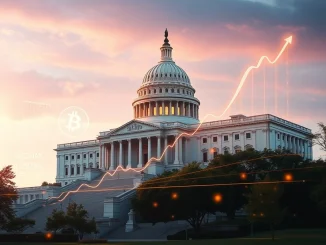
Hold onto your hats, crypto enthusiasts! The digital currency rollercoaster just took another dip, and this time, it’s got many altcoins reeling. Recent data reveals a significant crypto market correction, with nearly a quarter of the top 200 cryptocurrencies hitting their lowest prices in over a year. Is this the end of the bull run, or just a speed bump on the road to crypto glory? Let’s dive into what’s happening and what it means for your portfolio.
Why Are So Many Cryptocurrencies Hitting Yearly Lows?
According to Real Vision’s sharp-eyed analyst, Jamie Coutts, a staggering 24% of the top 200 cryptocurrencies plummeted to yearly lows following a notable market downturn on February 7th. This marks the highest percentage since August 5, 2024 (which saw 28%). This data, initially reported by Cointelegraph, paints a picture of widespread pressure across the digital asset landscape.
But what’s fueling this downward trend? Several factors are likely at play:
- Market-wide Correction: The crypto market is known for its volatility. Periodic corrections are a natural part of the cycle, allowing the market to cool down after periods of rapid growth.
- Liquidation Cascade: IntoTheBlock analyst Juan Pellicer points to significant liquidations, especially in Solana (SOL), as a key indicator. These large sell-offs can trigger a domino effect, pushing prices down further as leveraged positions are forcefully closed.
- Investor Capitulation?: Pellicer suggests this wave of yearly lows could signal investor capitulation. Capitulation happens when investors, fearing further losses, sell off their assets, often at a loss. This can sometimes mark the bottom of a market cycle.
| Factor | Description |
| Market Correction | Natural cooling period after price surges |
| Liquidation Cascade | Forced selling due to leveraged positions |
| Investor Capitulation | Fear-driven selling, potentially marking market bottom |
Solana Under Pressure: A Sign of Broader Altcoin Weakness?
The mention of Solana (SOL) experiencing significant liquidations is noteworthy. Solana has been a star performer in the recent bull run, and its struggles could be indicative of broader weakness in the altcoins market. When a leading altcoin like Solana faces selling pressure, it can send ripples throughout the entire altcoin ecosystem.
Is this a buying opportunity or a reason to be concerned about altcoins? That’s the million-dollar question. While some might see these lower prices as a chance to buy the dip, others are wary of further declines. The truth likely lies somewhere in between, and careful analysis is crucial.
Is the Bull Market Over? Experts Weigh In on the Market Downturn
Despite the concerning number of cryptocurrencies hitting yearly lows, not everyone is convinced that the bull market is over. Juan Pellicer from IntoTheBlock, for instance, believes the bull run could still have legs. He points to factors outside the crypto space that could provide continued upward pressure:
- US-China Trade Tensions: Geopolitical uncertainties and trade disputes can sometimes drive investors towards alternative assets like cryptocurrencies.
- AI-Driven Valuations: The ongoing hype and investment in Artificial Intelligence (AI) could indirectly benefit the crypto market, as both sectors are seen as innovative and high-growth.
These external factors suggest that there’s still potential for a market rebound. However, it’s essential to acknowledge the inherent risks and uncertainties in the crypto market.
The Memecoin Frenzy: A Double-Edged Sword for Altcoins
Adding another layer of complexity, Edwin Mata, CEO of Brickken, highlights the impact of the memecoin craze. While memecoins can bring excitement and new capital into the crypto space, Mata warns that the resulting liquidity fragmentation could actually limit the upside potential for established altcoins.
Here’s the potential downside of the memecoin mania:
- Liquidity Fragmentation: Capital gets diverted into a multitude of memecoins, spreading liquidity thin across the broader altcoin market. This can make it harder for more fundamentally sound projects to attract significant investment.
- Increased Volatility and Speculation: Memecoins are inherently driven by hype and speculation, injecting more volatility into the overall market. This can make it more challenging to predict market movements and increases the risk for all crypto investors.
Navigating the Crypto Market Correction: Actionable Insights
So, what should you do amidst this crypto market correction? Here are a few actionable insights to consider:
- Do Your Research: Now, more than ever, it’s crucial to thoroughly research any cryptocurrency you’re considering investing in. Understand its fundamentals, technology, and long-term potential.
- Manage Risk: Avoid over-leveraging and only invest what you can afford to lose. Market corrections are a reminder of the inherent risks in crypto.
- Consider Dollar-Cost Averaging (DCA): Instead of trying to time the market bottom, DCA involves investing a fixed amount of money at regular intervals. This can help mitigate the risk of buying at the peak and take advantage of lower prices during downturns.
- Stay Informed: Keep up-to-date with market news and analysis from reputable sources to make informed decisions.
Conclusion: Is This Crypto Dip a Disaster or Discount?
The current market downturn, with a significant percentage of cryptocurrencies hitting yearly lows, is undoubtedly a concerning signal. However, it’s crucial to remember that market corrections are a natural part of the crypto cycle. While the road ahead might be bumpy, history suggests that these periods can also present opportunities for those who are prepared and informed.
Whether this dip turns out to be a disaster or a discount ultimately depends on a multitude of factors, including broader market sentiment, macroeconomic conditions, and the continued evolution of the crypto space. Stay vigilant, stay informed, and navigate this volatile landscape with caution and strategic thinking.



